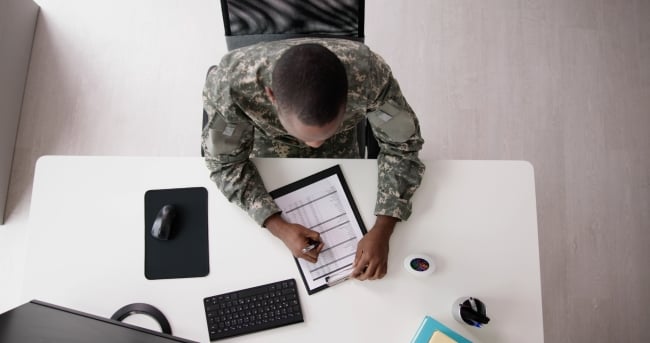You have /5 articles left.
Sign up for a free account or log in.

According to a new report, nearly half of institutions with three years of data on credit for prior learning have seen an increase in CPL pathways offered over that time period. Similarly, about half report an increase in the evaluation of CPL or number of credits awarded.
Andrey Popov/iStock/Getty Images Plus
The American Association of Collegiate Registrars and Admissions Officers (AACRAO) details the current state of credit for prior learning (CPL)—including prevalence of CPL sources of credit accepted and how it gets applied—in a just-released report. But more than that, it urges colleges and universities to increase such credit-awarding opportunities and build a “more inclusive, effective higher-education system that recognizes and values the diverse experiences and knowledge of learners.”
Wendy Kilgore, AACRAO’s senior director of research, says the paper aims to reach higher ed leaders at all levels, from those shaping system, state and federal policy to administrators making strategic decisions about institutional priorities and resource allocation to faculty and staff members working directly with learners to evaluate learning and award credit.
“We wanted to equip this broad audience with a comprehensive picture of the current CPL landscape and encourage meaningful discussions about how to enhance and expand these opportunities going forward,” she adds.
Credit for Prior Learning in Action
- The University of Akron’s prior-learning initiative, aimed at adult learners, offers academic credit for relevant knowledge and skills they may have acquired through alternative learning experiences. Credit for prior learning can come from professional certifications, work history, military services, previous college coursework, self-directed study and more.
- In North Carolina, the
- Front Range Community College in Colorado states on its CPL webpage that it can save learners between $1,600 and $6,000, on average. Ways to earn credit include work and life experiences, informal courses and training, community and volunteer extension courses, individual study and reading, plus civic, community and volunteer work. Credit is awarded based on a prior learning assessment by exam or portfolio. The learning must be college-level, applicable to the declared course of study and meet or exceed a “C” grade.
- Delaware postsecondary education institutions together developed the Delaware Credit for Prior Learning Policy Framework, which provides CPL guidance for Delaware colleges, universities and post–high school education programs on awarding CPL. The state’s Department of Education says this can save learners thousands of dollars in tuition and months of time.
- The City University of New York School of Professional Studies has an online tool to help learners identify workplace, military and volunteer experiences that may qualify for CPL and predict credit awarded. The total credit from portfolio evaluation, examination, noncollegiate learning and corporate or military training may not exceed 45 credits. The total of all CPL, including transfer credit, cannot exceed 105 credits.
Source: AACRAO
Defining terms: What is credit for prior learning? Borrowing from the Council for Adult and Experiential Learning, a partner for the report, AACRAO defines CPL as “assessment mechanisms colleges, universities and other education or training providers use to evaluate learning that occurred outside traditional academic environments. Used to grant college credit, certification or advanced standing toward further education or training. It may also be called prior learning assessment (PLA), recognition of prior learning and/or recognition of learning.”
CPL can be evaluated in the following ways:
- Individualized assessment, via a portfolio of work or life experiences, skill demonstration or interview.
- Faculty-developed exam
- Evaluation of noncollege programs, drawing on resources from the American Council on Education, National College Credit Recommendation Service, military credit or other national certifications.
- Conversion of institutional noncredit to credit.
What the report says: AACRAO’s paper is based on survey results from 399 responding institutions, mostly in the U.S. and a few (5 percent) in Canada. Four in five (82 percent) of all responding institutions offer one or more CPL pathways to learners. That’s about the same as the last time AACRAO surveyed institutions on this issue, in 2019 (79 percent). CPL is more common at public institutions than private nonprofit ones. A handful of institutions are currently adding CPL programs.
Other data points suggest some progress on CPL, however. Among institutions with three years of data on CPL, nearly half (46 percent) report an increase in CPL pathways offered over that time period. Similarly, about half (48 percent) report an increase in the evaluation of CPL or number of credits awarded through CPL pathways.
The most recognized sources of CPL are military experience (91 percent), professional experiences and licensing (88 percent), noncredit courses (80 percent) and other learning acquired outside of the traditional teaching environment (74 percent). Where CPL is offered, it’s accepted across a wide range of program requirements, such as those for electives (91 percent), majors (90 percent) and general education (87 percent).
Focus on transfer: Still, just over half of institutions (54 percent) won’t accept CPL in transfer cases, regardless of whether the institution otherwise offers CPL. AACRAO expresses particular concern over this gap in CPL pathways, arguing that institutions “should view the acceptance of CPL credits in transfer as an opportunity to support learner success and promote lifelong learning.” Acknowledging that many administrators and faculty members worry about integrity and rigor here, the report recommends they partner with other institutions to “develop agreements and align their CPL policies and practices.”
Most colleges and universities (67 percent) also charge for one or more types of CPL, beyond any standardized testing fee, and few offer financial assistance to offset any such costs to the learner. The most common kind of CPL fee is charged per credit hour awarded, less than that of tuition.
Seven in 10 institutions (71 percent) require admission to the institution before the student’s prior learning can be evaluated for possible credit and most (85 percent) limit how much CPL can be applied to any credential.
Benefits and challenges: In open-ended questions, responding institutions indicate that offering learners CPL boosts completion and retention, as well as recruitment and support for specific learner populations. It also lowers costs for many learners.
Challenges related to CPL, meanwhile, involve resource and staffing constraints, lack of streamlined policies and procedures, getting faculty buy-in and building institutional awareness. Three in 10 respondents (30 percent) report that their institution has less than one full-time staff member dedicated to CPL. Most of the rest (45 percent) have four or fewer dedicated staff members. Relatively fewer respondents say this level of staffing is sufficient to meet CPL needs than said so in AACRAO’s 2019 survey on the topic.
On awareness, just four in 10 (40 percent) of 2024 survey respondents say faculty members are aware of CPL options for learners. And most institutions (65 percent) don’t offer faculty members extra compensation to conduct CPL evaluations.
Call to action: Kilgore says individual institutions will ideally recognize the “need to prioritize the development and implementation of high-quality CPL policies and practices.”
She highlights these recommendations for practice:
- Establish clear, consistent and transparent processes for evaluating and awarding CPL credits that are aligned with the institution’s mission, academic standards and learner-success goals.
- Invest in the necessary resources, infrastructure and expertise to support CPL efforts, including dedicated staff, faculty training, technology solutions and learner outreach.
- Collaborate with other institutions, especially primary transfer partners, to ensure that CPL credits are widely recognized, transferable and relevant to workforce needs.
- Regularly assess and report on the impact of CPL on key learner outcomes like retention, completion and post-graduation success. Then use that data to improve CPL programs and services.
Kilgore says the report also underscores “the need for collective action and leadership across the higher-education sector to address systemic barriers to CPL success.” This includes:
- Promoting the wide adoption of consistent standards and guidelines for CPL assessment, transcription and transfer.
- Investing in research and innovation to identify, validate and scale effective CPL models and practices.
- Creating greater public awareness and understanding of the value and benefits of CPL, and empowering learners to make informed decisions about their education and career pathways.
Ultimately, Kilgore calls CPL “a powerful tool for advancing our shared goals of increasing access, affordability, completion and workforce readiness. By recognizing the knowledge and skills that learners bring from their prior experiences, we can help them save time and money, accelerate their progress toward a credential, and build confidence in their ability to succeed.”
As a sector, she adds, “we have an opportunity and an obligation to value learning in all its forms and empower learners to leverage their prior experiences for academic and career success.”
Looking ahead: Melanie Booth, executive director of the Higher Learning Commission’s Credential Lab, which was not involved in the report, says AACRAO’s work advances the “legitimacy of CPL in engaging and supporting today’s learners. It demonstrates the importance of broadening access and increasing the recognition of learning people bring with them or gain outside of higher education.”
More practically, Booth says colleges and universities may find value in benchmarking their own CPL practices and adopting strategies from the report.
Advancements are occurring in “many of areas related to CPL, including state and system initiatives and data collection and analysis,” Booth continues. Moreover, with many employers starting to move toward skills-based hiring, “skill-based CPL practices can help build bridges for learners to career opportunities in addition to serving as on-ramps to further education.”





